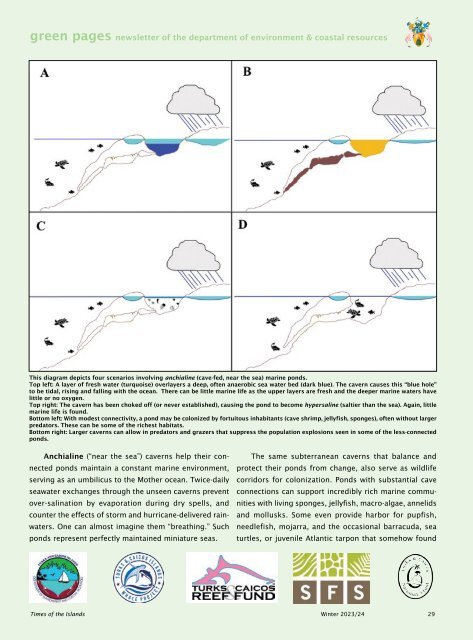Times of the Islands Winter 2023/24
Presents the "soul of the Turks & Caicos Islands" with in-depth features about local people, culture, history, environment, real estate, businesses, resorts, restaurants and activities.
Presents the "soul of the Turks & Caicos Islands" with in-depth features about local people, culture, history, environment, real estate, businesses, resorts, restaurants and activities.
You also want an ePaper? Increase the reach of your titles
YUMPU automatically turns print PDFs into web optimized ePapers that Google loves.
green pages newsletter <strong>of</strong> <strong>the</strong> department <strong>of</strong> environment & coastal resources<br />
This diagram depicts four scenarios involving anchialine (cave-fed, near <strong>the</strong> sea) marine ponds.<br />
Top left: A layer <strong>of</strong> fresh water (turquoise) overlayers a deep, <strong>of</strong>ten anaerobic sea water bed (dark blue). The cavern causes this “blue hole”<br />
to be tidal, rising and falling with <strong>the</strong> ocean. There can be little marine life as <strong>the</strong> upper layers are fresh and <strong>the</strong> deeper marine waters have<br />
little or no oxygen.<br />
Top right: The cavern has been choked <strong>of</strong>f (or never established), causing <strong>the</strong> pond to become hypersaline (saltier than <strong>the</strong> sea). Again, little<br />
marine life is found.<br />
Bottom left: With modest connectivity, a pond may be colonized by fortuitous inhabitants (cave shrimp, jellyfish, sponges), <strong>of</strong>ten without larger<br />
predators. These can be some <strong>of</strong> <strong>the</strong> richest habitats.<br />
Bottom right: Larger caverns can allow in predators and grazers that suppress <strong>the</strong> population explosions seen in some <strong>of</strong> <strong>the</strong> less-connected<br />
ponds.<br />
Anchialine (“near <strong>the</strong> sea”) caverns help <strong>the</strong>ir connected<br />
ponds maintain a constant marine environment,<br />
serving as an umbilicus to <strong>the</strong> Mo<strong>the</strong>r ocean. Twice-daily<br />
seawater exchanges through <strong>the</strong> unseen caverns prevent<br />
over-salination by evaporation during dry spells, and<br />
counter <strong>the</strong> effects <strong>of</strong> storm and hurricane-delivered rainwaters.<br />
One can almost imagine <strong>the</strong>m “breathing.” Such<br />
ponds represent perfectly maintained miniature seas.<br />
The same subterranean caverns that balance and<br />
protect <strong>the</strong>ir ponds from change, also serve as wildlife<br />
corridors for colonization. Ponds with substantial cave<br />
connections can support incredibly rich marine communities<br />
with living sponges, jellyfish, macro-algae, annelids<br />
and mollusks. Some even provide harbor for pupfish,<br />
needlefish, mojarra, and <strong>the</strong> occasional barracuda, sea<br />
turtles, or juvenile Atlantic tarpon that somehow found<br />
<strong>Times</strong> <strong>of</strong> <strong>the</strong> <strong>Islands</strong> <strong>Winter</strong> <strong>2023</strong>/<strong>24</strong> 29
















